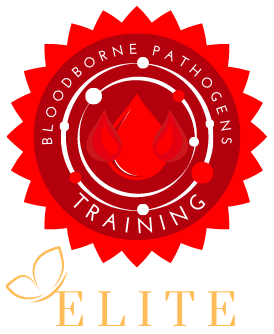Bloodborne Pathogens Courses
In this course, you will learn about all of the requirements and standards set forth by the Los Angeles Health Department’s Body Art Program for Bloodborne Pathogen Exposure Control. Once you complete this course you will be provided with a BBP Certificate.
$23.00
97 Lessons
Certificate



Certification is Approved/Accepted in the following counties:
Butte
El Dorado
Frenso
Kern
Los Angeles
Marin
Merced
Nevada
Orange
Plumas
Riverside
Sacramento
San Diego
San Francisco
Santa Barbara
Sonoma
Tulare
Ventura
Yolo
Yuba
San Luis Obispo
Inyo
Shasta
Kings
Alameda
Placer
Mono County
San Luis Obispo
Inyo
Shasta
Kings
Alameda
Placer
We are working towards having our Bloodborne Pathogens course by Accepted/Approved in as many counties as possible, to set our students up for success no matter where they decide to work.
Course Content
Elite Bloodborne Pathogens Training is committed to providing body artists with a comprehensive online Bloodborne Pathogen training course that is compliant with all OSHA standards. This course is engaging, affordable, accessible, and designed specifically for the tattoo and piercing industry.
- Acute Infection
- Antiseptic
- Approval
- Blood Exposure Incident
- Bloodborne Pathogen
- Body Art
- Body Art Facility
- Body Art Practitioner
- Body Piercing
- Branding
- Chronic Infection
- Client
- Contaminated
- Contaminated Waste
- Cosmetic
- Disinfectant
- Disinfection
- Ear Piercing
- Handwashing Facility
- Infection Prevention Control Plan
- Informed Consent Form
- Instrument
- Jewelry
- Medical History Questionnaire
- Minor
- Owner or Operator
- Permanent Cosmetics
- Permanent Hole
- Permit
- Course Syllabus
- Introductions to Bloodborne Pathogens Standards
- Safe Body Art Act
- Entry Point
- Group A Streptococcus Definition
- Group A Streptococcus Prevention
- Group A Streptococcus Transmission
- Hepatitis Definition
- Hepatitis Early warnings
- Hepatitis Prevention
- Hepatitis Statistics
- Hepatitis Transmission
- Herpes Complications
- Herpes Definition
- HIV and AIDS Definition
- HIV and AIDS Prevention
- HIV and AIDS Transmission
- How Infections Occur
- Malaria and Syphilis Definition
- Malaria and Syphilis Prevention
- Malaria and syphilis Transmission
- Staph and MRSA Definition
- Staph and MRSA Prevention
- Staph and MRSA Transmission
- Susceptible Host
- Antiseptics
- Cleaning Up Spills
- Cross-Contamination
- Disinfection Chemicals
- Gloves and PPE
- Hand Antiseptics
- Handwashing
- Handwashing Procedures
- Infection Prevention Control Plan
- Other Personal Protective Equipment
- Piercing Procedure
- Post-Care Instructions
- Procedural Safety
- Procedures
- Sanitary Breakdown
- Sanitation
- Sterilization Process
- Tattoo Procedure
- Waste Containers
- Waste Disposal
In the United States, OSHA mandates that body art practitioners must complete annual training in Bloodborne Pathogens before they can renew their licenses.
This training is designed to establish safety protocols for protecting workers from the potential health risks associated with exposure to blood and other infectious materials, thereby reducing their vulnerability to such hazards.
Examples of these health risks encompass, among others, Hepatitis B, Hepatitis C, HIV, Malaria, Brucellosis, Syphilis, West Nile Virus, and more. Our training program is specifically designed for individuals seeking OSHA Bloodborne Pathogen certification to meet the training requirements outlined in the OSHA Bloodborne Pathogen standard
- Documents
- Body Art Practitioner Registration Renewal
- Hepatitis B Vaccination Declination Form
- Informed Consent to Body Art Form (sample)
- Medical History Questionnaire (sample form)
- Hepatitis B Vaccine Information Sheet
- Body Art Facility Infection Prevention and Control Plan
- Blood Borne Pathogen Final Exam
Online Access
The Elite Bloodborne Pathogens Training is intended to educate students on bloodborne pathogens and diseases, avoid exposure, and what to do if exposed to infectious material.
Begin taking this course the moment you sign up. You can work at your own pace and will have complete access after successful completion of the course.
$23.00
